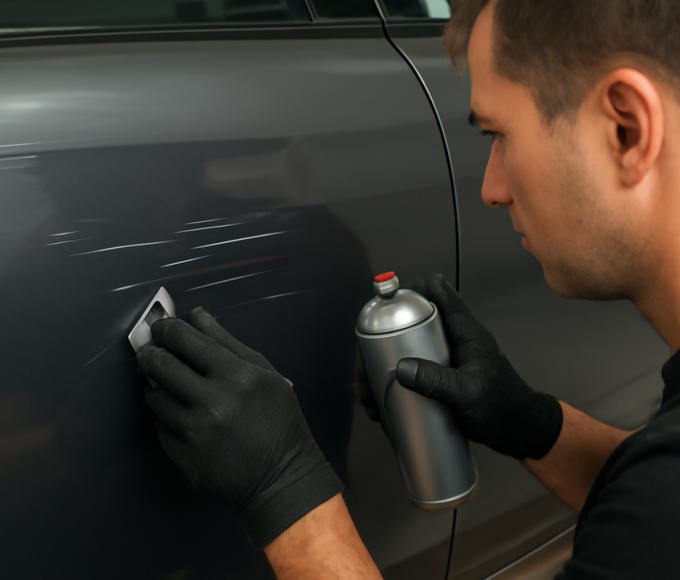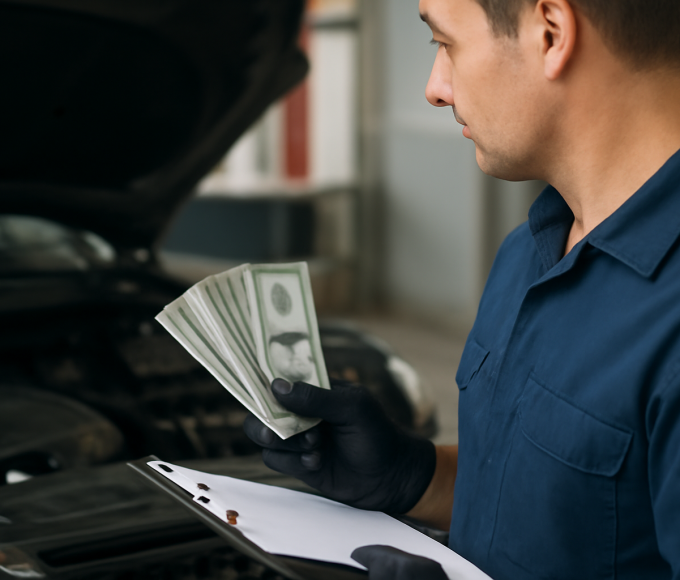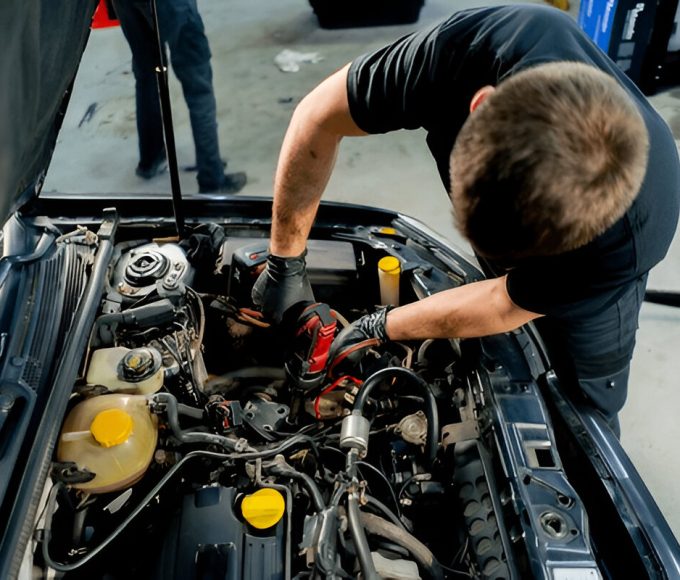Imagine a silent noon in late June. The pavement shimmers, and the sky feels like an open oven. You slide behind the wheel, twist the key, and instantly crank the A/C. Sadly, a blast of desert heat slaps your face instead of an icy rush. You wonder what went wrong and how to fix it. You are not alone; thousands of motorists face the same sweaty shock each summer. Throughout this guide, you will uncover every common cause, learn quick tests, and pick up smart habits that keep cabins frosty. Keep reading because this oneAC problem could ruin your summer car drive if you overlook the early hints.
Low Refrigerant—When the Coolant Runs Low
Refrigerant is the lifeblood of any automotive air-conditioning system. It circulates, absorbs cabin heat, and then releases it at the condenser. Yet, tiny leaks in rubber hoses or metal joints can let the gas seep away. The system gradually loses its ability to generate the pressure required for adequate cooling. Therefore, vents blow tepid air even when the dial sits at “LO.” If ignored, this oneAC problem could ruin your summer car drive during the first real heatwave. Furthermore, running with low refrigerant starves the compressor’s lubrication, accelerating wear. Because refrigerant prices have climbed sharply, catching leaks early saves money and comfort.
Warning Clues of a Refrigerant Leak
Although leaks hide, your car sends signals:
- Warm air when the fan speed is high
- The compressor clutch fails to click on
- Hissing near A/C lines after shutdown
- Oily stains on hose connections
Consequently, topping up gas unthinkingly rarely works. A certified technician should inject fluorescent dye, trace the escape point, repair the breach, and recharge to precise factory specs.
Broken Compressor—The Heartbeat Stops
If the refrigerant is the blood, the compressor is the heart. It squeezes the gas, pushes it through coils, and keeps the cycle alive. Once the clutch seizes or the internal bearings grind apart, cooling stops instantly. The first hint is often a screech or rattle that rises and falls with engine speed. Quick action matters because replacement parts and labor are expensive; otherwise, this AC problem could ruin your summer car drive and repair budget in one blow.
Major Causes of Compressor Failure
- Age-related wear of pistons and valves
- Electrical overload in the clutch coil
- Metal debris from earlier component failures
- Chronic low refrigerant starvation lubrication
Schedule an inspection as soon as odd noises appear. Early diagnosis sometimes allows a rebuild rather than a full swap, trimming costs dramatically.
Dirty Condenser or Stalled Cooling Fan
The heat from the cabin must leave the vehicle at the condenser mounted in front of the radiator. However, leaves, bugs, and road grit can block airflow, while a faulty electric fan may never spin. Consequently, high-side pressures soar, and cabin temperatures follow. During long red-light waits, sweat forms because this oneAC problem could ruin your summer car drive when heat cannot escape.
Fast Fix: Pop the hood, shine a flashlight through the grille, and spray away debris with low-pressure water. Next, watch the fan: it should whirl when the A/C engages. A relay, fuse, or motor could be dead if it remains still.
What If It’s Only Hot While Idling?
You cruise comfortably at 60 km/h, yet the cabin turns stale when traffic stalls. Moving air naturally cools the condenser; only the fan can do that job at idle. Therefore, a weak fan or dirty fins become apparent when the vehicle is at a standstill. Gridlock magnifies the misery, and this oneAC problem could ruin your summer drive during rush hour. Do not shrug it off. Testing fan speed, relay function, and condenser cleanliness now prevents bigger failures in mid-July.
Electrical Gremlins—Tiny Faults, Big Heat
Modern air conditioning relies on sensors, switches, and relays. One blown fuse can silence the compressor, and one corroded connector can confuse a pressure switch. These faults often occur unexpectedly, turning otherwise enjoyable trips into tumultuous experiences. Moreover, this oneAC problem could ruin your summer car drive even when every mechanical part remains perfect. A quick multimeter check across fuses and relays often restores chill within minutes and doesn’t cost much.
Can a Weak Battery Affect the AC?
Surprisingly, yes. The control module may shut the compressor off when the voltage drops to save power for ignition and fuel pumps. Drivers often notice dim lights and slow cranking, yet they miss the link to lukewarm vents. The strain worsens if multiple accessories run—headlights, stereo, phone chargers. Therefore, this oneAC problem could ruin your summer drive simply because the battery cannot keep pace. Have the battery load-tested; swapping it may revive starting power and cold airflow.
Airflow Blockages—Cool Air Stuck Behind Dust
Even when the evaporator coil produces frigid air, a clogged cabin filter or failing blower motor can trap that chill. Then you feel only a faint puff, like breathing through a stuffy nose. Over time, reduced circulation forces the system to run longer, wearing parts faster. Plus, this one AC problem could ruin your summer drive on extended road trips when fresh air matters most.
Quick Relief Steps
- Remove and inspect the cabin filter (typically behind the glove box).
- Clear the dust from the vent louvers.
- Listen for changes in blower speed across settings.
The motor or its resistor pack may need replacement if the airflow is weak.
Easy DIY Checks Before You Pay a Mechanic
Before reaching for the credit card, perform four speedy tests:
- Confirm settings. Dial the temperature to the lowest point and choose recirculation.
- Inspect the grille. Clear away leaves or plastic bags blocking the condenser.
- Watch the fan. Make sure it spins whenever the A/C runs.
- Gauge system pressure. A DIY recharge kit can indicate an obvious undercharge, but professionals should still handle precise filling.
Ignoring these basics invites bigger trouble, and this oneAC problem could ruin your summer drive sooner than expected.
Warm on One Side? Dual-Zone Troubles
Modern cabins often use blend doors and tiny stepper motors to split airflow between the driver and the passenger. When one of those motors sticks, or its plastic gear strips, cool air flows to one side while the opposite vent turns lukewarm. Because the symptom initially feels minor, drivers usually blame the sun beating through a window and keep rolling.
However, the longer the actuator remains jammed, the greater the strain on the blower and temperature sensors. Compressor cycling grows erratic, fuel economy suffers, and passengers fight over seat positions. A quick diagnostic scan at any repair shop pinpoints which actuator failed; replacing it typically takes less than an hour. Ignoring the imbalance risks cracking the fragile door, turning an inexpensive fix into dashboard-removal labor.
Routine Maintenance—Stay Cool Year-Round
Preventive habits cost little, yet they pay off all season. Firstly, switch on the air conditioning for ten minutes every two weeks, even in winter; seals stay supple, and oil coats internal surfaces. Secondly, a spring checkup should be scheduled to measure the refrigerant and inspect the belts. Thirdly, replace the cabin filter annually. Although simple, these steps mean this oneAC problem could ruin your summer drive far less often because you catch weaknesses before heat waves hit.
Smart AC Tech—Great, But Basics Still Rule
Many late-model vehicles boast dual-zone climate control, sunlight sensors, and eco-friendly R-1234yf refrigerant. Some even add ventilated seats that siphon warmth directly from passengers. Nevertheless, fancy electronics cannot overcome a clogged condenser or a hollow refrigerant line. Remember, this oneAC problem could ruin your summer drive, even inside a luxury sedan. Therefore, keep fundamentals—clean airflow, proper charge, solid electrics—at the top of your checklist.
How Much Might You Spend on Repairs?
| Issue | Typical Cost (CAD) (Estimated) |
| Cabin filter change | $30–$50 |
| Refrigerant recharge | $150–$350 |
| Blower motor swap | $200–$400 |
| Condenser cleaning | $50–$100 |
| Compressor replacement | $600–$1,500 |
| Electrical diagnostics | $100–$200 |
Due to regional and model price variations, it is advisable to request a written estimate initially. Still, early fixes usually land near the lower end, while delayed repairs climb rapidly. Consequently, delaying repairs for this AC problem could ruin your summer car drive and drain your wallet.
Engine Overheating Can Silence the AC
Your cooling system and air conditioning are more connected than they appear. When the engine temperature climbs past the safe zone, the powertrain module often shuts off the compressor to lighten the thermal load. At first, the move protects the motor, yet hot air pours from the vents inside the cabin without warning. Overheating stems from low coolant, a weak water pump, or a clogged radiator, and each fault grows worse the longer the compressor stays disabled.
Meanwhile, idle speeds rise, fuel burns faster, and summer traffic becomes torture. Therefore, any sudden switch from frigid to fiery air deserves an under-hood check for coolant leaks or a stuck thermostat. Fixing the root cooling issue restores engine health and steady cold airflow in one preventive strike.
Warning Signs, You Shouldn’t Ignore
A/C failure rarely appears from nowhere. Watch for these red flags:
- Sudden warmth after cold start-up
- Unusual clicks, squeals, or grinding when the A/C engages
- Moisture or mildew odors at vent outlets
- Frequent fog on interior glass despite defrost mode
Treat any alert as a prompt for inspection. If you ignore the symptoms, this one AC problem could ruin your summer car drive.
Choosing a Trustworthy Repair Shop
When professional help becomes unavoidable, pick a garage that:
- Holds Automotive Service Excellence or manufacturer certifications
- Provides transparent written quotes
- It uses UV dye or electronic sniffers to locate leaks, not guesswork
- Guarantees parts and labor for at least twelve months
Such shops charge fair prices, and they fix underlying faults rather than merely topping up gas. As a result, you regain reliable cooling and peace of mind.
Final Thoughts—Stay Cool, Drive Happy
Summer roads should lead to beaches, barbecues, and mountain lakes, not sweaty misery inside your vehicle. Whether the cause is low refrigerant, a lazy fan, or a slipping compressor clutch, quick checks and steady habits keep you ahead of trouble. Remember, throughout the hottest months, that this oneAC problem could ruin your summer car drive only if you ignore the early whispers. Address minor issues promptly, conduct regular tests, and your vents will provide you with refreshing air mile after mile.
Summary Checklist for Fast Relief
- Inspect the cabin filter and replace it if it is dirty.
- Clear debris from the condenser fins.
- Verify cooling-fan operation when idle.
- Listen for compressor noises.
- Test battery health during accessory load.
- Schedule an annual system pressure check.
Follow that plan, and long, sun-soaked journeys will remain a pleasure rather than a perspiration contest.

















Leave a comment